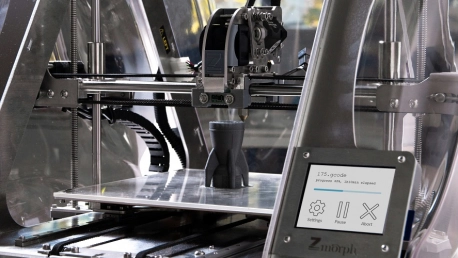Additive manufacturing (AM) and 3D printing came into the tech scene as some of the most disruptive technologies, indicating that we are on the precipice of the fourth industrial revolution. These advancements have affected pharmaceutical market growth, which has expanded by 17% annually between 2020 and 2023. This article will explore how additive manufacturing drives innovation in the biopharmaceutical realm.
It is important to note that some sources use “additive manufacturing” and “3D printing” interchangeably. However, additive manufacturing is a wider term and includes several industrial methods. We will come back to that later. On the other hand, 3D printing is a more straightforward practice, and it primarily includes non-industrial applications, which is very common among hobbyists. So, let us shed some light on the advent of additive manufacturing and explore how personalized medicine technologies impact the pharmaceutical industry.
Breaking New Ground With Precision Medicine
Precision medicine is a fresh approach to healthcare. Individualized prevention and treatment plans stand out as its ground-breaking objectives. Here, the term personalized refers to the customization of care based on each person’s unique physiology, lifestyle, and genetic composition.
Traditionally, the production of medicine, pills especially, no matter if they’re chemically or biologically derived comes in large batches. These conventional drug production lines have several drawbacks – starting with inaccurate prescription doses. However, the pharmaceutical industry and its branches, such as biopharma, are changing. We are moving towards more precise engineering, with less waiting time throughout the process.
Packed-bed chromatography has emerged as the dominant method for bioseparation, aiding biopharma in this technological revolution. Companies prefer packed-bed chromatography due to the high-resolution results. But, as innovative and trailblazing as it is, it is still really expensive, especially when it comes to high-dose biopharmaceuticals. Again, that is where additive manufacturing comes into play, as it can compensate for the increased need for new bioseparation methods. In fact, the anticipated increase in the adoption of additive manufacturing is as high as 45% among biopharma companies at the beginning of 2024. Companies like FabRx and Frontier Bio are good examples of leaders in this sector, with a focus on 3D printers for personalized pills and tissue bioprinters.
Data Disparity Issues in Biopharmaceutical Manufacturing
As shown in the introduction, the pharmaceutical market is increasing rapidly. Precision medicine tailors healthcare to individual needs, considering factors such as body composition, lifestyle, and genetics. 3D printing in tablet production creates precise dosages, allowing patients to intake correct drug combinations tailored to each individual. This advancement has the potential to minimize medication wastage. However, there are hurdles biopharma has to overcome before the widespread adoption of 3D-printed medications.
One hurdle we haven’t been able to overcome is how scientists collect data in biopharmaceutical manufacturing. Their process varies depending on when they measure the data and what type it is. For example, biopharma studies collect some measurements, like dissolved oxygen, optical density, and pH in real-time and continuously. However, other types of data have to be collected offline and at irregular times. So, this disparity makes it hard for scientists to create a solid system to collect different-looking data or to develop seamless ways to analyze it.
One way for drug manufacturers in the field to ensure they have the best data system and ensure the quality of the final product is to employ process analytical technology, or PAT for short. PAT is a framework that helps biopharma professionals design, analyze, and oversee manufacturing processes, facilitating their efforts to manufacture premium products. Therefore, meeting customer demands and enhancing the company’s brand reputation becomes much easier down the production line. PAT accomplishes this by relying on raw and in-process materials, as well as timely measurements.
Addressing Challenges in Mass Drug Production
Tablets are the primary orally administered cures for many diseases. However, companies produce them in large bulk quantities that usually result in doses not optimal for individual patients, as we already mentioned. Doctors normally try to tailor prescriptions by splitting tablets or combining different medications.
But the biggest disadvantage of that habit is a less-than-successful drug release into the bloodstream. In fact, studies have shown inaccurate doses show signs of decreased stability. On top of that, mass-producing medicine has a dangerous potential for patients to consume numerous pills and mix vastly different drugs at the same time. To be completely fair, sometimes doctors don’t have much flexibility in setting the proper patient dosage. So when you add that to people not taking their medicine correctly, whether they skip a dosage and then double it to make up for it, it leads to some very possible yet unfortunate side effects. Hence, tailoring drug doses to an individual’s lifestyle, location, and genetics could potentially solve these issues, and 3D printing just might be the catalyst to fully customizable medical care.
3D printing allows for the production of different sizes of pills, which can be tailored for each individual patient. Custom-sized tablets reduce the number of pills they need to take and make it much easier for patients to stick to their treatment—great news for people managing long-term health conditions or who have trouble keeping track of their doses.
How Does Additive Manufacturing Work?
The medical industry is increasingly using additively manufactured parts, especially for personalized implants and devices designed to fit specific patients. Additive manufacturing builds objects layer by layer. There are several distinct additive manufacturing processes with their standards, which include:
- Binder Jetting: A method that involves alternatively stacking layers of powdered material and liquid binder with a 3D printing head. It is a very cost-effective and fast process. It works best with metals, ceramics, composites, and sand in AM furnaces.
- Material Extrusion: A common AM technique that uses polymers coiled through a hot nozzle mounted on a moving arm while a nozzle moves them, melts them, and pushes them through a hot tip, building layer by layer. They stick together thanks to heat or special chemicals.
- Powder Bed Fusion: It enables several AM methods, such as direct metal laser melting (DMLM), direct metal laser sintering (DMLS), electron beam melting (EBM), selective laser sintering (SLS), and selective heat sintering (SHS). Powder bed fusion partially or completely melts thin layers of material using electron beams, lasers, or heat, then removes the extra powder, also employing furnaces for additive manufacturing.
- Sheet Lamination: Methods such as laminated object manufacturing (LOM) or ultrasonic additive manufacturing (UAM) build layers by using different materials, like paper with adhesive or thin metal sheets bonded together through ultrasonic welding.
- Vat Polymerisation: A container filled with liquid resin photopolymer hardens layer by layer with ultraviolet light, making it perfect for crafting intricate objects.
- Wire Arc Additive Manufacturing: This method utilizes arc welding power sources and manipulators to create objects by following a predetermined path with wire material.
- Directed Energy Deposition (DED): DED deposits and melts material at once, using ceramics, metals, and polymers. It works best for repairs, new part construction, and large-scale production with minimal tooling.
These methods are excellent options for making custom medical items because they can create very specific shapes, layer by layer. In extremely peculiar cases, doctors can employ magnetic imaging or CT scans to help get tailored molds for each patient. This way, we produce medical items faster, with less effort to customize them, while also gaining a few advantages: Additive manufacturing in biopharma reduces the need for repetitive surgeries, makes implants stay in place better, and assists bone growth, among many other applications.
The Role of Additive Manufacturing in Shaping the Future of Healthcare
In conclusion, additive manufacturing is a pivotal technology driving significant transformations not only in biopharmaceuticals but across various industries, such as aerospace, transportation, energy, and the consumer sector. Although exciting, we have just barely started to venture into the era of precision medicine, with personalized healthcare as the most important goal on the horizon. We still have ways to go before medicine tailored to individual needs becomes completely available and affordable for the masses. But who knows, there’s a chance that we’ll soon see smart factory-connected 3D printers on the cloud, allowing customers to order directly from the AM operator. As we embrace this technological revolution, additive manufacturing shows promise in reshaping the healthcare landscape, offering new possibilities, and lengthening the life span of humans worldwide.









